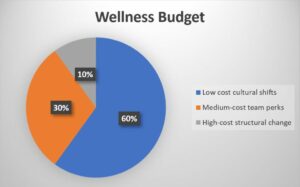Contents
- 1 How Much An Employee Wellness Program Cost?
- 2 Factors That Affects Employee Wellness Program Cost
- 3 How Can Be The Cost Of A Wellness Program Be Lowered?
- 4 Why Employee Wellness Programs Are Necessary?
- 5 Total Cost Of An Employee Wellness Program
- 6 Strategies To Implement Employee Wellness Program?
- 7 Employee Wellness Program At MantraCare
- 8 A Word From Mantra care
How Much An Employee Wellness Program Cost?

Employee wellness programs are often a cost-effective way to improve the health and well-being of employees. Many businesses have found that these programs have a positive return on investment in the form of reduced absenteeism, decreased healthcare costs, higher productivity, and lower employee turnover. Wellness programs can vary widely in scope and expense. But in general, the cost is much less than what employers spend on medical care for employees each year. The cost of healthcare for employees is a major expense for many businesses. These costs are on the rise, and employee wellness programs have been found to be an effective way to reduce these expenses. Employee wellness program cost lesser than healthcare prices.
Wellness programs vary in scope and expense. But employers should determine what they want their program to provide before starting one. Employers will also need to decide how much it is willing or able to spend on this endeavor. So that they know how big of a wellness program they can afford. It is important for employers not only to take into account the initial start-up costs. But also ongoing maintenance fees as well. Because those can add up quickly if you are not careful with your budgeting.
As with any employee benefit plan, the employer’s mission and workforce will play an important role when determining how much an employee wellness program should cost. Wellness programs have been shown to have a great return on investment. But only if you are willing to spend some money on them. This is especially true because many of the costs associated with wellness programs are ongoing. Therefore, it is important to take into account not only one-time startup fees but also long-term expenses as well when determining your wellness program budget.
Factors That Affects Employee Wellness Program Cost
Employees have a positive return on investment in the form of reduced absenteeism, decreased healthcare costs, higher productivity, and lower employee turnover. The amount of Employee Wellness Program depends on several factors.
Size Of Company

The size of the company is another important factor to consider when determining how much an employee wellness program should cost. Companies with fewer than 500 employees are more likely to have enough resources to implement an extensive wellness program with many features. Companies with 500-999 employees may find it beneficial to offer some additional services that are not offered through the company’s main health plan. Such as chiropractic care or acupuncture sessions. Larger companies may want to offer basic wellness programs that are consistent with their existing HR policy. For example, they may provide access to Gatorade or incentives for calorie consumption during company events.
The size of the business will play a large role in determining what type of wellness program is possible for your establishment. However, the more comprehensive the wellness program offered by employers, the higher the associated costs are likely to be. The bigger your company is and the more services you include in your wellness program. The more likely it will cost. You may want to start by looking at what other similar establishments offer before deciding where to begin for yourself.
Healthcare Plan

Additionally, the wellness program you offer may be influenced by the benefits package your employees receive through their health plan. For example, if your establishment is a UnitedHealthcare network provider and doesn’t offer massage chairs as part of its wellness program. It’s unlikely that many employees would spend an additional $50-60 to use one outside of work hours. However, standard workout equipment such as free weights and treadmills are usually expected among most employees regardless of job role or skill level.
Features Of Program
When determining how much your employee wellness program should cost, it’s important to consider many different aspects before beginning one. You’ll need to determine what features you want your employee wellness program to include and which ones you can afford; then you can determine an appropriate pricing structure. Employers should evaluate options for wellness programs by considering the factors mentioned above, including both one-time and ongoing costs.
Wellness programs have many benefits, but they also require a significant monetary investment. As with any employee benefit plan. It’s important to not only look at startup fees but also long-term expenses when figuring out how much your company can afford to spend on its program. This is especially true if you’re concerned with making this cost worthwhile through return on investment or reducing healthcare costs.
Even with these added expenses, though, wellness programs can result in a positive return on investment for employers. Additionally, The Return On Investment For Employee Wellness Programs found that employees have a positive return on investment in the form of reduced absenteeism, decreased healthcare costs, higher productivity, and lower employee turnover. With an extensive plan, you’re sure to get results like increased productivity and decreased healthcare costs but your budget needs to. If you don’t include all the bells and whistles, you can still create a nice wellness plan for your employees.
How Can Be The Cost Of A Wellness Program Be Lowered?

The cost of employee wellness programs varies widely depending on their scope and features, but all employers can benefit from implementing some kind of workplace health promotion plan. Wellness programs have been found to be very cost-effective in terms of reducing healthcare costs for employees. There are several factors that will play an important role in this decision, including what you expect your program to provide and how much you are willing or able to spend. It is important that businesses make both one-time and ongoing costs into account when determining how much they can spend on their wellness program. Realistically, doing something fun with your co-workers can also be a less expensive way of reaching common goals. These are some simple ways to reduce wellness program cost.
Limit Incentives
 One of the ways wellness program cost can be lowered is by managing wellness incentives well. It might seem like this would not make people want to participate. But it actually has been shown to increase participation rates. For example, having a potluck where everyone brings in their favorite dish to share with the group. Simply getting everyone together and bringing in some food to share can be a great way for employees to feel connected. And can help them see that they do have common goals within the office. This will also allow people to work at their own pace and create an environment of connectedness and teamwork among staff members. The ones who may not otherwise interact on a day-to-day basis. Another way in which you could lower the cost of your wellness program is through limiting incentives or rewards if needed.
One of the ways wellness program cost can be lowered is by managing wellness incentives well. It might seem like this would not make people want to participate. But it actually has been shown to increase participation rates. For example, having a potluck where everyone brings in their favorite dish to share with the group. Simply getting everyone together and bringing in some food to share can be a great way for employees to feel connected. And can help them see that they do have common goals within the office. This will also allow people to work at their own pace and create an environment of connectedness and teamwork among staff members. The ones who may not otherwise interact on a day-to-day basis. Another way in which you could lower the cost of your wellness program is through limiting incentives or rewards if needed.
Seek What Motivates Employees
You should start by finding out from your employees what might motivate them before offering prizes that may not end up being used or desired. For example, it would be counter-productive to offer an employee who does not commute by car a gas card. If your wellness program mostly focuses on bike riding for transportation. By limiting the incentive you are saving money and focusing on what will actually motivate employees.
Partner With Local Vendors
A third way in which you could lower the cost of your wellness program is through partnering with local vendors or other businesses within the community. This allows businesses to take advantage of outside sources without having to spend their own company’s resources. It also allows companies to come together with like-minded people and work towards common goals that benefit employees as well as keep prices manageable. The goal should always be to find ways in which costs can be lowered while creating a fun, engaging environment for all parties involved.
Limit Program Features
 Once employers have calculated how much money they would like to invest in their wellness program. They can start deciding what kind of features will be included. Health-related activities (e.g., weight loss programs) tend to cost less than comprehensive programs. That also includes non-health services (e.g., personal development seminars). The more expansive the wellness program, the higher the associated costs are likely to be. However, there is a point at which these additional services provide enough additional value to outweigh their added expense.
Once employers have calculated how much money they would like to invest in their wellness program. They can start deciding what kind of features will be included. Health-related activities (e.g., weight loss programs) tend to cost less than comprehensive programs. That also includes non-health services (e.g., personal development seminars). The more expansive the wellness program, the higher the associated costs are likely to be. However, there is a point at which these additional services provide enough additional value to outweigh their added expense.
Examples Of Incentives Used To Lower Wellness Program Cost?
Some examples of possible incentives include free massages, free lunches, discounts on gym memberships, or other exercise-related activities. As well as health challenges where employees compete against one another to reach a common goal. Such as hitting a certain number of steps on a pedometer during the course of a week. There are even companies out there that will allow employees to donate prizes from their own homes without lowering the value for those who win. This allows everyone within an office or business unit to feel included and encourages people to work together. In some cases, it’s just a good old competitive spirit that motivates many individuals interested in wellness.
Why Employee Wellness Programs Are Necessary?
Employee wellness programs became popular in the 1990s and continue to gain in popularity among companies looking for ways to improve their bottom line while creating a better work-life balance for employees which strengthens overall morale.”
Employee wellness programs aren’t just for people with chronic conditions. Those who are obese, those who smoke, and those with diabetes or cardiovascular disease may not be the only ones who need to improve their health. More importantly, it can make a big difference to an employee’s productivity and ability to do his or her job well. Employee wellness programs can help employees feel better about themselves. As well as the company that cares about their workers’ well-being.
Total Cost Of An Employee Wellness Program

“Employee wellness programs can vary greatly in terms of pricing and what they offer. They can range from $300 to $2,500 per year or more.”
Using this information we find that the average employee wellness program costs around $1,147 per year. It equals a little under $100 a month for employees who sign up and participate within their company’s wellness program for an entire year. And take full advantage of all offered incentives and programs.
A wellness program is a way to ensure that your employees are healthy and happy. It helps them be more productive, reduces healthcare costs, and can even help with recruiting new personnel. The best part of all? A wellness program doesn’t have to cost you an arm and a leg. In fact, many companies start their programs for less than $50 per month. To learn about the different types of employee wellness programs available or how we can help create one for your company contact us today.
Strategies To Implement Employee Wellness Program?

The best way to start this is by first doing a needs assessment. You will want to determine what your employees want, who they are. And what you can offer them in terms of incentives. Once you have this list you can go back through it and make sure that everyone’s input has been considered. The next step is to reach out within the community for partners with similar goals as yours. They might be able to help spread the word about your incentive options. Or even provide discounts on products or services which your employees might enjoy. As stated before, simply bringing people together with common interests can be enjoyable for many. So, by reaching out within your community you are not only saving valuable company dollars but creating a sense of community.
With these suggestions in mind, you should be able to save money on your wellness program. While still creating an engaging environment for employees. Keep in mind that the goal is not to spend less and less money each year. But rather create a long-term investment with benefits that will last throughout the years.
Employee Wellness Program At MantraCare
Participants (workers and their qualified family/household members) can reach out to their counselors via phone calls, text messages, live video chats, and other methods.
Mantra Care’s EAP and MAP (member assistance program), according to its website, focus on the four main pillars:
Participants and members can access their services and resources in a variety of ways.
The organization will develop a bespoke plan to engage your staff based on your specific demands.
The company designed its overall experience with mental health and substance abuse issues in mind.
Mantra Care believes in providing outcomes, which is why each annual case study is published. To show, over 70% of participants report increased productivity as a result of using their EAP.
A Word From Mantra care
Do you want to keep your employees happy, healthy, and productive? Join our employee assistance program and get a healthier workplace.


